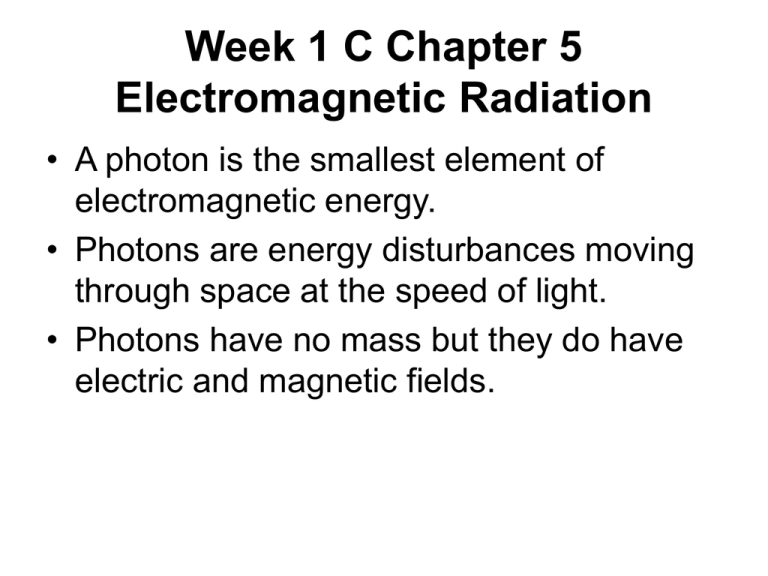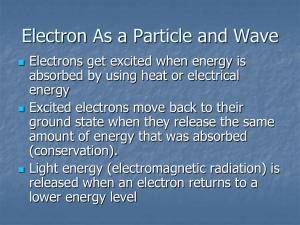Week 1 C Chapter 5 Electromagnetic Radiation
advertisement

Week 1 C Chapter 5 Electromagnetic Radiation • A photon is the smallest element of electromagnetic energy. • Photons are energy disturbances moving through space at the speed of light. • Photons have no mass but they do have electric and magnetic fields. Electromagnetic Radiation • A field is an interaction between different energies, forces or masses that can not be seen but can be described mathematically. • Electromagnetic Radiation can be represented by the sine-wave model. • Sine-waves have amplitude.Amplitude is one half the range from crest to valley over a sine wave. Electromagnetic Radiation • The important properties of the sine-wave model are frequency(f) and wavelength(λ) and velocity. • Frequency is the number of wavelengths passing a point per second. • Frequency is identified as oscillations per second and measured in hertz (Hz). Electromagnetic Radiation • Wavelength is the distance from one crest to another or from any point in the wave to the next corresponding point. • The wave parameters are very important. A change in one affects the value of one or both of the others. Electromagnetic Radiation • At a given velocity, wavelength and frequency are inversely proportional. • The Wave Formula • Velocity= Frequency x Wavelength Electromagnetic Radiation • With EMF we know the velocity so the formula is simplified. • c= fλ or f= c/λ or λ= c/f • As frequency increases, wavelength decreases and vice versa • For electromagnetic radiation, frequency and wavelength are inversely proportional. Electromagnetic Spectrum • The electromagnetic spectrum includes the entire range of electromagnetic radiation. • The frequency range is from about 102 to 1024 Hz • Photon wavelengths range from 107 to 10-16m. • Grouped together, these radiations make up the electromagnetic spectrum. Electromagnetic Spectrum • Three important ranges. • Visible light • Radio frequency • X-radiation • Others include: – UV – IR and microwave Electromagnetic Spectrum • EMF can be measured in three formats • Energy (eV) used to describe x-rays • Frequency (Hz) • Wavelength (m) Visible Light • Measured in wavelength. • A prism is used to refract or change the direction of the photons. • Only form of EMF that we can sense. Forms of Light • Visible light ranges from 700nm to 400nm wavelength. • Infrared light have longer wavelength than visible light but shorter than microwaves. • Ultraviolet light is located between visible light and ionizing radiation. Radiofrequency • AM radio, FM radio and Television are other forms of electromagnetic radiation. • With radio, the frequency is used to identify the station. • Short wavelength radiofrequency are referred to as microwaves. Ionizing Radiation • Unlike visible light or radiofrequency, ionizing electromagnetic radiation is characterized by the energy contained in the photon. • When we use 70 kVp, the photon will have energy varying from 0 to 70 keV. Ionizing Radiation • The frequency is much higher and wavelength much shorter for x-rays compared to any other form of electromagnetic radiation. • Visible light identified by wavelength • Radiofrequency identified by frequency • X-rays identified by energy Ionizing Radiation • The only difference between X-rays and gamma rays is their origin. • X-rays are produced outside the nucleus. • Gamma rays are produced inside the nucleus of radioactive atoms. Wave-Particle Duality • A x-radiation photon and a visible light photon are fundamentally the same except that x-radiation photons have a much higher frequency and shorter wavelength. • These differences change the way they interact with matter. • Visible light tends to behave as waves. Wave-Particle Duality • X-radiation tends to behave more as particles than waves. • Both types of photons exhibit both types of behavior and this is referred to as the wave-particle duality of radiation. • Photons interact with matter when the matter is approximately the same size as the photon wavelength. Wave-Particle Duality • Radio & television photons wavelength is measured in meters and interact with long metal rods called antennae. • Microwave are measured in centimeters and react most easily with popcorn & hotdogs. Wave-Particle Duality • Visible light wavelength is measured in micrometers or nanometers, interacts with living cells such as the rods and cones in the eye. • Ultraviolet light interacts with molecules. • X-rays interact with atoms and electrons. • All radiation with wavelengths longer than x-rays interact primarily as a wave. Wave model: Visible Light • Vision is result of specially developed organ that sense a very narrow portion of the electromagnetic spectrum. • When a visible light photon strikes an object, it sets the molecule of the object into vibration. Wave model: Visible Light • The orbital electrons become excited by the higher energy. This energy is immediately irradiated as another photon of light. This is referred to as reflection. • Atomic and molecular structure determine which wavelength of light are reflected. Wave model: Visible Light • Light photons not reflected are either absorbed or transmitted. • There are three degrees of absorption: – Transparency – Translucency – Opacity Degrees of Absorption • If all of the light is transmitted almost unaltered, it is transparent. • If only some of the light passes through , it is called translucent. Degrees of Absorption • If all of the light is absorbed, it is called opaque. • Attenuation is the sum of scattering and and absorption of radiation. Radiopaque or Radiolucent • Terms used to describe the appearance of objects on the x-ray film. • Objects that absorb the radiation are called radiopaque. Radiopaque or Radiolucent • Structures that attenuate the x-rays are referred to as Radiolucent. • Bone is radiopaque. • Lung is radiolucent. Inverse Square Law • Radiation intensity is inversely proportional to the square of the distance from the source. • The reason for the decrease is the radiation is spread over a wider area. Inverse Square Law • The Inverse Square Law is used in radiography to adjust technical factors for changes in distance. • It is also used for radiation protection. The farther you are away from the source, the lower the exposure. Particle Model: Quantum Theory • Unlike other forms of electromagnetic radiation, x-ray energy is measured in electron volts (eV). • X-ray energies range from 1 to 50 MeV • X-ray wavelengths range from 10-9 to 1012m. • X-ray frequency range from 1018 to 1021Hz Range of X-ray Energies • Diagnostic Radiography uses the range of 30 kVp to 150 kVp. • Grenz rays with energies of 10 to 20 kVp are used in dermatology. • Therapy uses energies from 200 to 1000 kVp X-ray Waveform • X-rays have both electric and magnetic fields. • One wave represents the electric field and one the magnetic field varying at right angles to each other. Planck’s Quantum Theory • X-rays are created at the speed of light or they don’t exist at all. • The energy of a photon is directly proportional to it’s frequency. • A photon’s energy is inversely proportional to the photon wavelength. Matter and Energy • Like the law of the conservation of matter, the law of conservation of energy states that Energy can be neither created or destroyed. • Planck’s quantum physics and Einstein’s physics of relativity greatly extended these theories. Matter and Energy • According to quantum physics and physics of relativity, matter can be transformed into energy and vise versa. • Although matter and energy are interchangeable, it is energy from the x-ray photon interacting with tissue and the image receptor that forms the basis of xray imaging. Mass Energy Relationship • Mass and energy are two forms of the same medium. This scale shows the equivalence of mass measured in kilograms to energy measured in electron volts. End of Lecture









